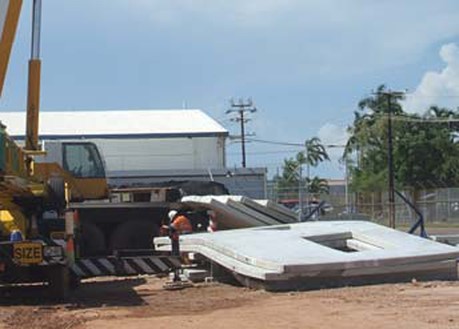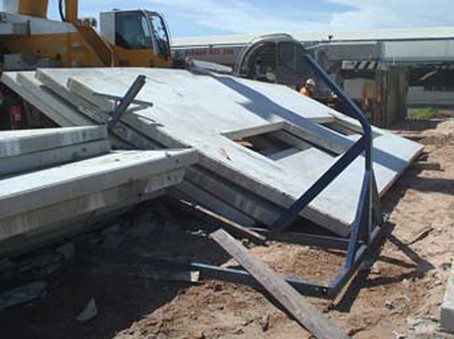Collapse of precast concrete elements stored in fabricated racking
The purpose of this Safety Alert is to highlight the risk of collapse of precast concrete elements stored in fabricated racking.
Background
Eleven precast concrete elements (panels) weighing approximately 100 tonnes and stored in a steel rack on a local construction site collapsed on 9 March 2009. Fortunately there were no people in the vicinity of the rack at the time of the collapse but the elements and the rack struck and damaged a mobile crane on site. Workers were routinely in the area of the rack as part of their work and could have been crushed and killed or seriously injured.


Contributing factors
- The rack was not designed or tested to determine its safe load capacity and the large number of elements being stored arose from the stockpiling as a result of the sequencing of erection
- The steel storage rack was not fabricated in accordance with any engineering calculations or certification of its safety for the purpose it was to be used
- The large number of elements being stored in the rack was clearly beyond its safe capacity, resulting in collapse.
Action required
There is a National Code of Practice for precast, tilt-up and concrete elements in building construction (the Code) which was release in February 2008 by Safe Work Australia that provides valuable guidance for those working with or handling concrete elements. A concrete element means a concrete panel or other precast concrete element, made in either an on-site or off-site casting yard that is cast then lifted into position to form part of a building.
Section 6.2 of the Code provides the following information in relation to the storage of concrete elements:
- The concrete elements should only be stored in a position approved by an engineer
- Racking systems, frames and supports should be designed by an engineer for the shape, size and weight of the concrete element
- Approval and written instructions should be obtained from the engineer before a concrete element is stored horizontally
- Approval and written instructions should be obtained from the engineer before a concrete element is stored on a suspended floor slab or beams. This is particularly important in a situation where it becomes necessary to put a concrete element to into unplanned temporary storage. E.g. where the erection of a concrete element to the temporary braced condition cannot be finalised. If approval by an engineer cannot be obtained, the concrete element must be returned to ground level
- During storage, care should be taken to minimise the likelihood of impact between the concrete elements. Where the concrete elements are stored in areas of vehicular movement, protection by the way of bollards or other physical barriers and appropriate warning signs should be provided
- Prefabricated concrete elements should only be stored in a designated area and in such a manner as to minimise multiple handing.
It is recommended that those in control of construction sites where concrete elements are used and stored or panel yards take steps to ensure that the arrangements they have in place are safe. The Code should be referred to for guidance.
In particular, sites storing concrete elements in racks or otherwise should examine the racks or other stillages they use for this purpose and if necessary seek the advice of an engineer to ensure they are safe and appropriate for the purpose.
Further information
Legislation
- Work Health and Safety (National Uniform Legislation) Act 2011 (Section 19)
- Work Health and Safety (National Uniform Legislation) Regulations 2011 (Part 3.1)
Code of Practice
Disclaimer
This Safety Alert contains safety information following inquires made by NT WorkSafe about an incident or unsafe practice. The information contained in this Alert does not necessarily include the outcome of NT WorkSafe’s action with respect to an incident. NT WorkSafe does not warrant the information in this Alert is complete or up-to-date and does not accept any liability for the information in this report or as to its use.